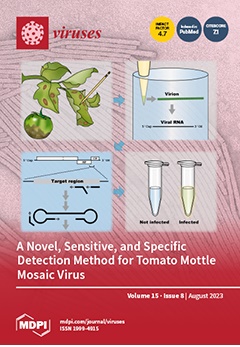Ver ítem
- xmlui.general.dspace_homeCentros e Institutos de InvestigaciónCICVyA. Centro de Investigación en Ciencias Veterinarias y AgronómicasInstituto de VirologíaArtículos científicosxmlui.ArtifactBrowser.ItemViewer.trail
- Inicio
- Centros e Institutos de Investigación
- CICVyA. Centro de Investigación en Ciencias Veterinarias y Agronómicas
- Instituto de Virología
- Artículos científicos
- Ver ítem
Quadruplex real-time TaqMan® RT-qPCR assay for differentiation of equine group A and B rotaviruses and Identification of group A G3 and G14 genotypes
Resumen
Equine rotavirus A (ERVA) is the leading cause of diarrhea in foals, with G3P[12] and G14P[12] genotypes being the most prevalent. Recently, equine G3-like RVA was recognized as an emerging infection in children, and a group B equine rotavirus (ERVB) was identified as an emergent cause of foal diarrhea in the US. Thus, there is a need to adapt molecular diagnostic tools for improved detection and surveillance to identify emerging strains, understand their
[ver mas...]
Equine rotavirus A (ERVA) is the leading cause of diarrhea in foals, with G3P[12] and G14P[12] genotypes being the most prevalent. Recently, equine G3-like RVA was recognized as an emerging infection in children, and a group B equine rotavirus (ERVB) was identified as an emergent cause of foal diarrhea in the US. Thus, there is a need to adapt molecular diagnostic tools for improved detection and surveillance to identify emerging strains, understand their molecular epidemiology, and inform future vaccine development. We developed a quadruplex TaqMan® RT-qPCR assay for differentiation of ERVA and ERVB and simultaneous G-typing of ERVA strains, evaluated its analytical and clinical performance, and compared it to (1) a previously established ERVA triplex RT-qPCR assay and (2) standard RT-PCR assay and Sanger sequencing of PCR products. This quadruplex RT-qPCR assay demonstrated high sensitivity (>90%)/specificity (100%) for every target and high overall agreement (>96%). Comparison between the triplex and quadruplex assays revealed only a slightly higher sensitivity for the ERVA NSP3 target using the triplex format (p-value 0.008) while no significant differences were detected for other targets. This quadruplex RT-qPCR assay will significantly enhance rapid surveillance of both ERVA and ERVB circulating and emerging strains with potential for interspecies transmission.
[Cerrar]

Autor
Carossino, Mariano;
Balasuriya, Udeni B.R.;
Thieulent, Côme J.;
Barrandeguy, Maria Edith;
Vissani, Maria Aldana;
Parreño, Gladys Viviana;
Fuente
Viruses 15 (8) : 1626 (Agosto 2023)
Fecha
2023-07
Editorial
MDPI
ISSN
1999-4915
Formato
pdf
Tipo de documento
artículo
Palabras Claves
Derechos de acceso
Abierto
 Excepto donde se diga explicitamente, este item se publica bajo la siguiente descripción: Creative Commons Attribution-NonCommercial-ShareAlike 2.5 Unported (CC BY-NC-SA 2.5)
Excepto donde se diga explicitamente, este item se publica bajo la siguiente descripción: Creative Commons Attribution-NonCommercial-ShareAlike 2.5 Unported (CC BY-NC-SA 2.5)


